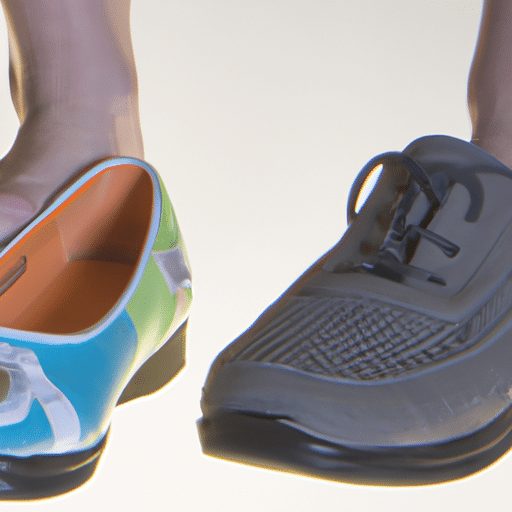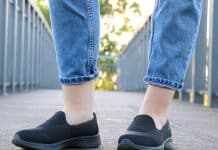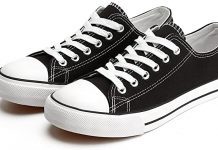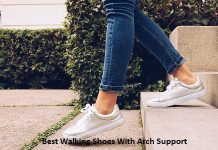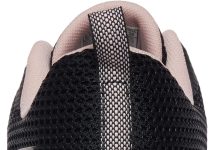When it comes to choosing the perfect pair of shoes, the question of whether to buy walking or running shoes often arises. With so many options available, it can be overwhelming to decide. In this article, let’s explore the factors that will help you make an informed choice. From the level of cushioning and support to the type of activities you engage in, we’ll highlight the key considerations to help you find your perfect fit. So, whether you’re a casual stroller or a dedicated marathon runner, join us as we unravel the mysteries of shoe buying and discover what truly works for you.
Factors to consider
When it comes to choosing the right footwear for your physical activities, there are several factors to consider. These factors will help ensure that you find the shoe that not only fits well but also supports your feet in the best possible way. The factors to consider include the intensity of activity, foot type, surface, and gait pattern.
Intensity of activity
The intensity of activity plays a crucial role in determining whether you should opt for walking shoes or running shoes. If you engage in low-impact activities such as casual walking or light hiking, walking shoes are generally sufficient. On the other hand, if you participate in high-impact activities like running or intense workouts, running shoes are designed to provide the necessary support and cushioning.
Foot type
Another important factor to consider is your foot type. Some people have high arches, while others have flat feet or neutral arches. It is essential to choose shoes that cater to your specific foot type to ensure proper alignment and support. Walking shoes often have a more flexible arch, while running shoes tend to have a more structured design to accommodate different foot types.
Surface
Consider the surface on which you will be primarily engaging in your activities. If you plan on walking or running on smooth, even surfaces like sidewalks or tracks, walking shoes will generally provide enough traction. However, if you anticipate running on rough terrains or trails with uneven surfaces, running shoes with a more aggressive tread pattern and enhanced grip will be more suitable.
Gait pattern
The way you walk or run, also known as your gait pattern, should be taken into account when choosing between walking and running shoes. Walking shoes are typically designed with a more rounded sole to accommodate the heel-to-toe rolling motion of walking. Running shoes, on the other hand, often have a stiffer sole to better support the heel strike and push-off motion associated with running.
Walking Shoes
Design and features
Walking shoes are specially designed to provide comfort and support for walking activities. They often have a more flexible and rounded sole to facilitate the natural heel-to-toe rolling motion of walking. Additionally, they may feature a lower profile design, providing a more lightweight and flexible option.
Cushioning
One of the essential features of walking shoes is adequate cushioning. This cushioning helps absorb shock and reduce the impact on your feet and joints as you walk. It provides a comfortable and smooth walking experience, making them suitable for extended periods of walking.
Flexibility
Walking shoes are designed to be more flexible compared to running shoes. This flexibility allows for a greater range of motion of the foot during the gait cycle. As a result, walking shoes provide a more natural and efficient movement, allowing your feet to comfortably adapt to different surfaces.
Heel-to-toe drop
The heel-to-toe drop refers to the height difference between the heel and the toe of a shoe. Walking shoes typically have a lower heel-to-toe drop compared to running shoes. This lower drop promotes a more natural foot strike and gait, reducing the strain on your feet and promoting proper alignment during walking activities.
Running Shoes
Design and features
Running shoes are specifically designed to provide the necessary support and cushioning for running activities. They often feature a more structured and sturdy design compared to walking shoes. Running shoes may have additional features such as mesh uppers for breathability and lightweight materials for enhanced performance.
Cushioning
One of the key features of running shoes is their ability to provide superior cushioning. The cushioning in running shoes helps absorb the impact generated during running, reducing the stress on your joints and muscles. This cushioning is especially important for those engaged in high-impact activities like running.
Stability
Running shoes offer increased stability compared to walking shoes, particularly for those with pronation issues. They are designed to provide support and control excessive foot motion, promoting a more stable running form. The stability features in running shoes can help prevent injuries and improve overall running performance.
Outsole durability
The outsole durability of running shoes is highly important, especially for those who engage in long-distance running. Running shoes often have a more durable outsole with a higher rubber content, providing better traction and longevity. This durability ensures that the shoes can withstand the wear and tear associated with extensive running.
Benefits of walking shoes
Promotes proper foot alignment
Walking shoes are designed to provide proper foot alignment during walking activities. They offer support and stability to ensure that your feet are properly positioned, reducing the risk of injuries and promoting better overall foot health.
Reduces pressure on joints
Walking can still put stress on your joints, especially if you have flat feet or high arches. Walking shoes provide cushioning and shock absorption, helping to reduce the pressure on your joints. This can minimize discomfort, prevent injuries, and make your walking experience more enjoyable.
Improves stability and balance
Walking shoes are designed to provide stability and balance, allowing you to navigate different surfaces with ease. The supportive features of walking shoes, such as a rounded sole and adequate arch support, help promote a more stable and balanced gait pattern.
Enhances comfort during extended walking
Walking shoes are designed with comfort in mind. With their cushioning, flexibility, and lightweight design, they are ideal for extended periods of walking. Whether you are exploring a new city or going on a leisurely stroll, walking shoes will provide the comfort you need to enjoy your walking experience.
Benefits of running shoes
Shock absorption
Running shoes excel at shock absorption, which is crucial for the repetitive impact that occurs during running. The enhanced cushioning and shock-absorbing materials in running shoes help protect your feet and joints from the high impact forces generated with each stride.
Provides support for high impact activities
Running shoes are specifically designed to provide the support needed for high-impact activities like running and intense workouts. They offer stability features and structured designs that can help prevent injuries and increase overall performance during rigorous activities.
Enhanced traction
The outsole of running shoes often features a specialized tread pattern to provide enhanced traction. This is particularly beneficial when running on various surfaces, including wet or slippery conditions. The improved traction of running shoes helps reduce the risk of slips and falls, ensuring a safer running experience.
Supports faster and more efficient running
Running shoes are built with features that support faster and more efficient running. The lightweight materials and responsive cushioning in running shoes can help improve your speed and stride efficiency. The design and features of running shoes are geared towards maximizing your running potential.
Potential drawbacks of walking shoes
Limited support for high-intensity activities
Walking shoes are primarily designed for low-impact activities like walking or light hiking. If you engage in high-intensity activities such as running or intense workouts, walking shoes may not provide the necessary support and cushioning needed for optimal performance and injury prevention.
Less cushioning for heavy impact
While walking shoes offer cushioning for moderate impact, they may not provide adequate support for heavy impact activities like running. The cushioning in walking shoes is typically softer and lighter, which may not be sufficient to absorb the impact forces generated during running.
Lower durability for long-distance running
If you plan on engaging in long-distance running, the durability of walking shoes may become an issue. The materials and construction of walking shoes are not typically designed to withstand the wear and tear associated with extensive running. Running shoes often have a higher level of durability to withstand the demands of longer distances.
Potential drawbacks of running shoes
Less stability for walking and standing
While running shoes offer excellent stability and support for running activities, they may be less stable for walking and standing. The stiffer sole and structured design of running shoes, which provide stability during running, may not offer the same level of comfort and stability for everyday walking or standing.
Increased weight and bulkiness
Running shoes are often more substantial and bulkier compared to walking shoes due to their added cushioning and support features. This increased weight and bulkiness can result in a less comfortable and less agile walking experience. If you prioritize lightweight and nimble footwear, running shoes may not be the best option.
Higher cost compared to walking shoes
Running shoes tend to be more expensive compared to walking shoes. The advanced materials, technologies, and designs used in running shoes contribute to their higher cost. If you are on a budget or prioritize affordability, walking shoes may be a more cost-effective option.
Choosing the right shoe for your needs
Identify your main activity
The first step in choosing the right shoe is to identify your main activity. Determine whether you primarily engage in low-impact activities like walking, or high-impact activities like running or intense workouts. This will help narrow down your options and ensure that you select shoes specifically designed for your specific activities.
Consider your foot type
Consider your foot type when choosing between walking and running shoes. If you have high arches, flat feet, or neutral arches, choose shoes that cater to your specific needs. Different shoes offer varying levels of arch support and stability features to accommodate different foot types.
Consult with a professional
It can be beneficial to consult with a professional, such as a podiatrist or a knowledgeable salesperson at a specialized shoe store. They can provide valuable insights and recommendations based on your specific foot type, gait pattern, and activity level. Their expertise will help ensure that you find the right shoe for your individual needs.
Try them on and test them out
Before making a final decision, it is essential to try on the shoes and test them out. Walk or run around the store or on a designated testing area to assess how the shoes feel on your feet. Pay attention to comfort, fit, and overall performance. Trying on multiple pairs and comparing different brands and models will help you find the perfect fit.
Conclusion
Choosing between walking shoes and running shoes ultimately depends on individual needs and preferences. It is essential to consider personal factors such as the intensity of your activities, foot type, and gait pattern when making a decision. Walking shoes excel in promoting proper foot alignment, reducing pressure on joints, improving stability, and enhancing comfort during extended walking. On the other hand, running shoes provide superior shock absorption, support for high-impact activities, enhanced traction, and faster running performance.
By considering these factors and weighing the benefits and potential drawbacks of each type of shoe, you can make an informed decision that meets your specific needs. Ultimately, finding the right balance between the design, features, and functionality of walking and running shoes will help ensure the best possible experience for your chosen activities. So lace up your shoes, hit the pavement, and enjoy your active lifestyle!

